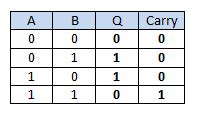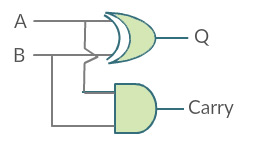2. Half Adder
The most basic binary addition possible is to add a pair of 1 bit numbers together. Let us call them $A,B$. In order to do this correctly, there must be two outputs - the result digit, and a carry bit.
These are the rules of binary addition:
$$ 0 + 0 = 0 \text{ carry 0}$$
$$ 0 + 1 = 1 \text{ carry 0}$$
$$ 1 + 0 = 1 \text{ carry 0}$$
$$ 1 + 1 = 0 \text{ carry 1}$$
Let us place these in a truth table where Q is the output digit and a carry bit:

The logic circuit for output $Q$ is an EXCLUSIVE OR gate i.e. the output is 1 when A or B is a 1 but not both.
The carry column is the logic of an AND gate i.e. the output is 1 only when A AND B is 1.
Now combine these two into a circuit:

This circuit can add two single bit numbers and produce a digit bit (Q) and a carry bit. It is called a 'half adder'.
It is called a half adder because it cannot deal with an incoming carry bit.
Next we shall describe a full adder.
Challenge see if you can find out one extra fact on this topic that we haven't already told you
Click on this link: discrete digital electronics
